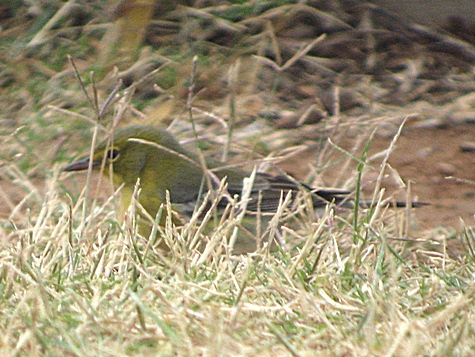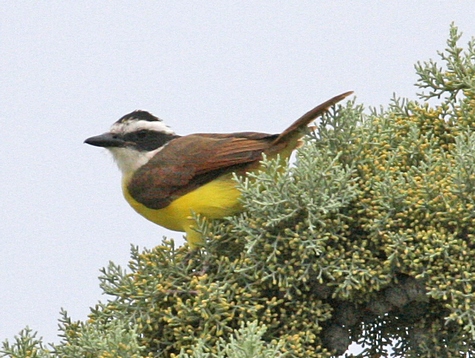I was just reflecting on our past week of birds in the Big Country and shaking my head as to the mixture that was found. This Sage Thrasher (above) was seen and photographed at Dyess AFB. It is a bird of the West, inhabiting sagebrush, brushy slopes, and mesas. It winters in the desert Southwest, and we’re at its northern wintering range. However, it is somewhat irregular in its wintering areas but it concentrates where there are good wild crops of berries.

On the same day the thrasher was seen, a Pine Warbler was out foraging for insects at the golf course at Dyess AFB. It is a bird of the East and breeds almost exclusively in pine woods. This is the third sighting in Taylor County the last 5 years or so. I’m still sleuthing to see how many, if any, sightings were made prior to this time frame. An uncamouflaged picture of this bird can be found at Cornell’s web site, All About Birds.

Remember this guy? The Great Kiskadee! He’s still here! Being a resident of the Lower Rio Grande Valley, he’s waaaaay north of his range. I had expected him to migrate south in the fall but our first blast of real winter weather accompanied by snow obviously didn’t move him out. He was seen at Wilhair Park eating juniper berries as fast as he could stuff them into his mouth on December 2. (Photo by JAEnglish)
Also on December 2 a Eurasian Wigeon was found among thousands of ducks at Lake O.H. Ivie in Coleman County. (The find is courtesy of Jay and Amy.) As its name implies, it breeds in Europe but occasionally flocks with American Wigeons in North America. Oops, I feel a rarity chase coming on!
I’ve collected a few more photographs of other birds found in the Big Country towards the end of November/beginning of December. Horned Grebe, Hooded Mergansers, Loggerhead Shrike and more can be seen in the Winter Mix gallery. What a mix of eastern/western, winter/resident, and north/south birds!